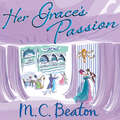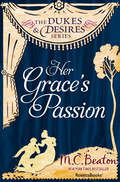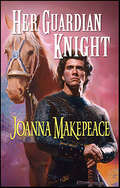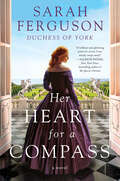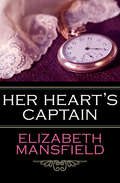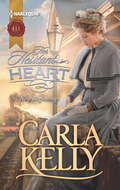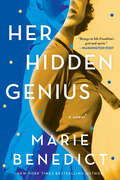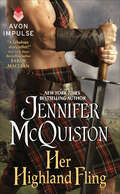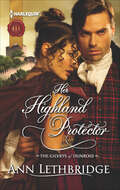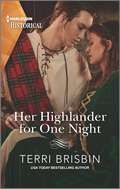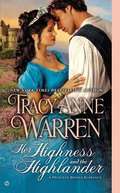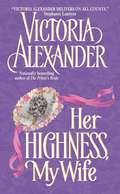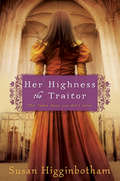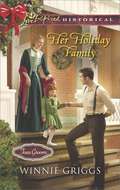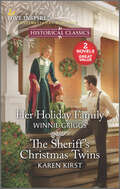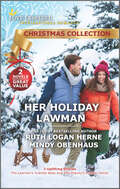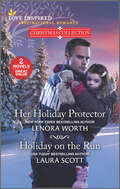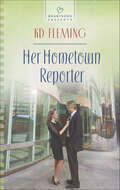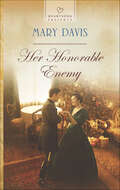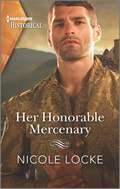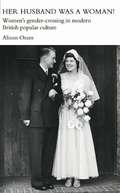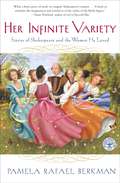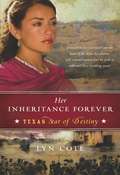- Table View
- List View
Her Grace's Passion (Regency Scandal #8)
by M.C. BeatonMatilda, Duchess of Hadshire, was a virtual prisoner of a cruel husband who romanced his mistress right under the duchess's nose. Her only joy was dreaming of the handsome Earl of Torridon - for he, like her, was trapped in a horrid marriage and longed to find true love and happiness.Though she secretly wished for the death of her unkind husband, Matilda never imagined the guilt that would plague her when the illustrious duke was befittingly murdered by his own regular lady! When Matilda turned to Torridon for comfort, she discovered a few surprises in store for both of them.
Her Grace's Passion (The Dukes and Desires Series #2)
by M. C. BeatonA Regency romance driven by secret longings and scandalous crimes—from the New York Times–bestselling author of the Agatha Raisin mysteries.Matilda, Duchess of Hadshire, was a virtual prisoner of a cruel husband who romanced his mistress right under the duchess’s nose. Her only joy was dreaming of the handsome Earl of Torridon—for he, like her, was trapped in a horrid marriage and longed to find true love and happiness. Though she secretly wished for the death of her unkind husband, Matilda never imagined the guilt that would plague her when the illustrious duke was befittingly murdered by his own regular lady! When Matilda turned to Torridon for comfort, she discovered a few surprises in store for both of them . . . Praise for M.C. Beaton “A romance writer who deftly blends humor and adventure . . . [sustaining] her devoted audience to the last gasp.” —Booklist“Veteran author Marion Chesney (aka M.C. Beaton) delivers top-notch Regency fare.” —RT Book Reviews
Her Guardian Knight
by Joanna MakepeaceCAUGHT BETWEEN LOYALTY AND LOVETheir first meeting was on a battlefield-he thought she was a camp follower, and she knew he was the enemy. But though Rosamund Kinnersley fought for her honor, she could not deny one mad moment of longing to give in to his passion for her....Orphaned by the bloody Wars of the Roses, Rosamund and her brother discover that their father’s death fighting on the Lancastrian side means their manor could be seized by the Yorkists. And Simon is the enemy knight appointed to act as their guardian. The passionate bond between Rosamund and Simon grows with every meeting-but can newfound love survive old loyalties and betrayals?
Her Heart for a Compass: A Novel
by Sarah Ferguson"A brilliant and glittering jewel of a novel. I was wholly swept away by this story."--Allison Pataki, New York Times bestselling author of The Queen's Secret“A tale of daring and determination, set against the glamorous heights, and the harsh restrictions of aristocratic society in the middle years of the British nineteenth century."--Sir Julian Fellowes, creator of "Downton Abbey"From one of the most famous former members of the British royal family, Sarah Ferguson, Duchess of York —a mesmerizing novel of a young noblewoman’s coming-of-age that richly details both high society and low in Victorian England.Queen Victoria’s close friend, the Scottish Duke of Buccleuch, Lady Margaret Montagu Scott is expected to make an advantageous marriage. But Margaret is an impulsive and outspoken girl in a repressive society where women are, quite literally, caged in corsets and required to conform.When Lady Margaret’s parents arrange a society marriage for her, she tries to reconcile herself to the match. But shortly before her betrothal is announced, Margaret flees, leaving her parents to explain her sudden absence to an opulent ballroom stuffed with two hundred distinguished guests. Banished from polite society, Margaret throws herself into charitable work and finds strength in a circle of female friends like herself—women intent on breaking the mold, including Queen Victoria’s daughter Princess Louise. Margaret resolves to follow her heart—a journey of self-discovery that will take her to Ireland, America, and then back to Britain where she finds the life she was always meant to lead.A bold and thoughtful story about a rebellious woman finding herself and her voice in an age of astounding technological change and great social unrest, Her Heart for a Compass is a delicious costume drama rich in atmosphere, history, and color.
Her Heart's Captain
by Elizabeth MansfieldAppearances can be deceiving in award-winning author Elizabeth Mansfield&’s seductive Regency tale about a woman who loses her heart to the one man she has sworn never to love When Jenny Garvin arrives at the Portsmouth pier to see her adored brother sail off on one of His Majesty&’s ships, she catches the eye of a tall, well-dressed stranger, who rescues her from a thief. But Captain Tristram Allenby is not what he seems. According to her brother, he is an icy-cold, monstrous tyrant who must be avoided at all costs. Tris Allenby only has eyes for the spirited beauty who has haunted his dreams for the past six months. Now the most sought-after bachelor in London wants the one woman who will have nothing to do with him. The battle lines have been drawn—but there are always two winners in the intriguing game of love.
Her Hesitant Heart: New Beginnings
by Carla KellyRITA Award–Winning Author: She’s starting a new life on the Wyoming frontier—but is her heart ready for a new love?Tired and hungry after two days of traveling, Susanna Hopkins is just about at the end of her tether when her train finally arrives in Cheyenne. She’s bound for a new life in a Western garrison town. Then she discovers she doesn’t even have enough money to pay for the stagecoach! Luckily for her, the compassionate Major Joseph Randolph is heading in the same direction.As a military surgeon, Joe is used to keeping his professional distance and tries not to dwell on Susanna’s understated beauty, But he’s drawn to this woman who carries loss and pain equal to his own and has a heart that is just as hesitant and wary. . . . “Kelly has the rare ability to create realistic yet sympathetic characters that linger in the mind.” —Library Journal
Her Hidden Genius: A Novel
by Marie Benedict"Fans of historical fiction will devour this complex portrait of a brilliant and trailblazing genius and the price she paid to advance the frontiers of science."—Beatriz Williams, New York Times bestselling author of Our Woman in MoscowThe new novel from the New York Times bestselling author of The Mystery of Mrs. Christie!She changed the world with her discovery. Three men took the credit.Rosalind Franklin has always been an outsider—brilliant, but different. Whether working at the laboratory she adored in Paris or toiling at a university in London, she feels closest to the science, those unchanging laws of physics and chemistry that guide her experiments. When she is assigned to work on DNA, she believes she can unearth its secrets.Rosalind knows if she just takes one more X-ray picture—one more after thousands—she can unlock the building blocks of life. Never again will she have to listen to her colleagues complain about her, especially Maurice Wilkins who'd rather conspire about genetics with James Watson and Francis Crick than work alongside her.Then it finally happens—the double helix structure of DNA reveals itself to her with perfect clarity. But what unfolds next, Rosalind could have never predicted.Marie Benedict's powerful new novel shines a light on a woman who sacrificed her life to discover the nature of our very DNA, a woman whose world-changing contributions were hidden by the men around her but whose relentless drive advanced our understanding of humankind.Also By Marie Benedict:The Other EinsteinCarnegie's MaidThe Only Woman in the RoomLady ClementineThe Mystery of Mrs. Christie
Her Highland Fling: A Novella
by Jennifer McQuistonLet the Games Begin …William MacKenzie has always been protective of his Scottish village. When Moraig's economy falters, he has the perfect solution to lure wealthy Londoners to this tiny hamlet: resurrect the ancient Highland Games! But for this to work, William knows he needs a reporter to showcase the town in just the right light.A female journalist might be a tolerated oddity in Brighton, but newly minted reporter Penelope Tolbertson is discovering that finding respect in London is a far more difficult prospect. After receiving an invitation to cover Moraig's Highland Games, Penelope is determined to prove to her London editors just how valuable she can be.Penelope instantly captures William's heart, but she is none too impressed with the gruff, broody Highlander; however, as she begins to understand his plans, Penelope discovers she may want more from him than just a story. She's only got a few days … but maybe a few days are all they need.
Her Highland Protector (The Gilvrys of Dunross #1144)
by Ann LethbridgeLady Jenna Aleyne must marry well if she is to claim her lands...Only, there is a complete lack of eligible suitors in the Highlands! But then Niall Gilvry is assigned to watch over Jenna, and there's no denying she finds this handsome Scot most distracting!Niall knows Jenna is too fine a lady for the likes of him-after all, high society has little time for a lowly third son-but he takes his duty seriously. With danger lurking in the shadows, Niall stays close. It would be just oh, so easy to pull her into his arms....
Her Highland Rogue: A Wild Highland Guardian Novel
by Violetta RandIn a breathtaking short novel that's perfect for readers of Maya Banks and Monica McCarty, Violetta Rand introduces a wild clan of Scottish warriors who fight for honor--and live for passion. Errol MacRae's days of gallivanting across the Highlands are nearing an end. His father's health has taken a turn for the worse, and rumors are swirling that the crown intends to transfer ancient lands into the hands of the MacKenzies, the clan the MacRaes are sworn to defend. Errol expects to lead his men into battle soon. So he isn't pleased when his father instead sends him to retrieve a beautiful flame-haired lass who has fled into the mountains. Orphaned as a young girl, Aileana vividly remembers how the MacRaes rescued her and welcomed her into their clan. For ten years, she has served them loyally--until the night she's nearly despoiled by one of the laird's captains. Aileana risks her life and her reputation to seek refuge in the snowcapped peaks of the Five Sisters, the one place that has always felt like home. But after the strong-armed, strong-willed Errol tracks her down in a blizzard, she finds herself tempted to risk something even more dangerous: her heart.Advance praise for Her Highland Rogue "A dazzling talent, Violetta Rand delivers everything readers want in a Scottish romance. Her Highland Rogue is pure delight, setting the pages on fire with great characters, edge-of-your-seat action, and sizzling passion. I couldn't put it down."--USA Today bestselling author Sue-Ellen Welfonder "Brace yourself for a spellbinding, page-turning, impossibly satisfying romantic ride."--Collette Cameron, award-winning author of Schemes Gone Amiss"With passion, mystery, and romance, Her Highland Rogue is a delight from start to finish."--Award-winning author Mary Wine"Violetta Rand captures the essence of the medieval Highlands and cleverly weaves a tale wrought with deception and the promise of new beginnings."--Amy Jarecki, author of The Fearless Highlander"Violetta Rand sweeps you away to the enchanted Highlands with an enthralling tale of soul-searching, danger, and passion."--Victoria Zak, author of the Guardians of Scotland series Includes a special message from the editor, as well as an excerpt from another Loveswept title.
Her Highlander for One Night (A Highland Feuding #7)
by Terri BrisbinA sexy Highlander story from USA TODAY bestselling author Terri BrisbinClaiming the warriorFor one night of pleasure!When Glynnis had to make a noble marriage, Iain Mackenzie Cameron&’s illegitimacy stood in the way. She married another—but now she&’s returned to the clan a widow, and Iain is an assured warrior, the chieftain&’s heir. Glynnis would make him a more than suitable bride—except for her inability to produce heirs. Iain must marry elsewhere…but only after she claims one precious impassioned night with him!From Harlequin Historical: Your romantic escape to the past.A Highland FeudingBook 1: Stolen by the HighlanderBook 2: The Highlander's Runaway BrideBook 3: Kidnapped by the Highland RogueBook 4: Claiming His Highland BrideBook 5: A Healer for the HighlanderBook 6: The Highlander's Inconvenient BrideBook 7: Her Highlander for One Night
Her Highness and the Highlander: A Princess Brides Romance
by Tracy Anne WarrenFrom New York Times bestselling author Tracy Anne Warren comes the second novel in an enchanting new trilogy about three princesses brought together by friendship and fate. This is Princess Mercedes’s story… While journeying home from Scotland, Princess Mercedes of Alden’s coach is set upon and her personal guard killed. Barely escaping with her life, she seeks help at a nearby inn. But with no money and looking little better than a beggar, the townsfolk think her claims of being a princess to be nothing more than a far-fetched tale. Utterly forsaken, Mercedes wonders what is to become of her. After years of soldiering, dispossessed Laird Daniel MacKinnon is finally coming home. At an inn he is confronted by a bedraggled young woman claiming to be of royal blood. Daniel doesn’t believe her wild tale, but when she asks for his protection, he agrees to serve as her bodyguard—in turn she promises to reward him handsomely once they reach London. But Mercedes is still being pursued by ruthless hunters whose motives remain unclear. As the danger increases, so does the desire she and Daniel feel for each other, until the two of them must face the greatest danger of all—falling in love. .
Her Highness, My Wife (Effington Family #5)
by Victoria AlexanderWomen never said no to the dashing Lord Matthew Weston and he never said no to them. But this was the first time he found one tempting enough to impetuously say "I do." Was it any wonder he awoke to discover her gone? And when Matthew learned the enchanting creature he'd married was of royal blood -- and would abandon their marriage bed without a second thought -- he vowed to put her out of his life forever.But even a princess makes mistakes. And now Tatiana's back, asking for the kind of help only he can give her. But is his assistance all she wants or are there secrets the willful royal is keeping from him? Matthew may well lend her his hand but he'll never again give her his heart. Still, he's determined to tame the green-eyed beauty and change her from a perfect princess to his passionate bride.
Her Highness, the Traitor
by Susan HigginbothamA daughter can be a dangerous weapon in the battle for the throne of EnglandFrances Grey harbored no dream of her children taking the throne. Cousin of the king, she knew the pitfalls of royalty and privilege. Better to marry them off, marry them well, perhaps to a clan like the Dudleys.Jane Dudley knew her husband was creeping closer to the throne, but someone had to take charge, for the good of the country. She couldn't see the twisted path they all would follow.The never-before-told story of the women behind the crowning of Jane Grey, this novel is a captivating peek at ambition gone awry, and the damage left in its wake.Praise for Susan Higginbotham's Novels"Susan Higginbotham transports her readers into a vividly portrayed past."—Helen Hollick, author of The Pendragon's Banner trilogy"Susan Higginbotham draws the reader under her spell...she brings the dead to life."—Christy English, author of The Queen's Pawn, praise for The Stolen Crown"A beautiful blending of turbulent history and deeply felt fiction...Higginbotham has given readers of historical fiction a gift to treasure."—Karen Harper, New York Times bestselling author of The Irish Princess, praise for The Queen of Last Hopes
Her Holiday Family
by Winnie GriggsTHE CHRISTMAS CHILDREN Reserved widow Eileen Pierce never considered herself the kind of woman who was cut out to be a mother. She wouldn't know what to do with one child, much less ten. But when handyman Simon Tucker is stranded in town with a group of young orphans at Christmastime, she discovers she can't just turn them away. Simon knows there's more to Eileen than meets the eye. Though his easygoing demeanor immediately clashes with her buttoned-up propriety, Simon's kindness soon melts Eileen's stern facade. Simon and the children already upended Eileen's quiet, orderly life. Will they do the same to her guarded heart? Texas Grooms: In search of their brides...
Her Holiday Family and The Sheriff's Christmas Twins
by Winnie Griggs Karen KirstSurprise Christmas blessingsHer Holiday Family by Winnie Griggs Reserved widow Eileen Pierce never considered herself cut out to be a mother. But when handyman Simon Tucker is stranded in town with ten young orphans at Christmastime, she can't just turn them away. Though Simon&’s easygoing demeanor clashes with Eileen&’s buttoned-up propriety, his kindness melts her stern facade. Soon Simon and the children upend Eileen's quiet, orderly life. Will they do the same to her guarded heart?The Sheriff's Christmas Twins by Karen Kirst Convinced that Allison Ashworth deserves better, Sheriff Shane Timmons has always tried to remain aloof. But with Allison in Gatlinburg for the holidays and caring for two motherless babies, Shane wants to help her. Allison has always been drawn to Shane, but he never seemed to look her way. Now, spending time with him and the twins gives her hope that her dreams of motherhood—and a life with Shane—may come true.
Her Holiday Lawman
by Ruth Logan Herne Mindy ObenhausTwo inspirational Christmas romances featuring handsome lawmen, from two great authors, together in one book.The Lawman’s Yuletide Baby by USA Today–bestselling author Ruth Logan HerneWidow Corinne Gallagher’s plans for a peaceful Christmas with her kids go astray when longtime crush Gabe Cutler moves in next door. As if having the handsome state trooper within snowball-throwing distance isn’t distracting enough, Gabe suddenly has custody of an orphaned baby and is in need of Corinne’s help! She agrees, but her heart draws a line—she can’t fall for another lawman!The Deputy’s Holiday Family by Mindy ObenhausLacie Collier wants to give her niece, Kenzie, the best Christmas! But that won’t be easy while spending the holidays with Lacie’s Christmas-averse mother. Sheriff’s deputy Matt Stephens is surprised to see Lacie back in Ouray. He’s always regretted that their friendship became strained after he started dating her sister in high school. But he’s more than shocked when he sees Kenzie, whose resemblance to Matt is undeniable . . .
Her Holiday Protector and Holiday on the Run
by Lenora Worth Laura ScottA holiday in hidingHer Holiday Protector by Lenora WorthWhen a killer comes after Rikki Allen, detective Blain Kent learns she’s the daughter of Franco Alvanetti, the notorious crime kingpin. A by-the-book former marine, Blain has made it his life mission to put the Alvanetti family out of business. Yet he has to trust Rikki to protect her from a killer who wants her dead by Christmas.Holiday on the Run by Laura ScottAfter witnessing a murder, Melissa Harris faked her death and went into hiding. For years, it worked—until now. When bullets begin to fly, SWAT cop—and Melissa’s former high school sweetheart—Nate Freemont rescues Melissa and her little girl. Now with Christmas approaching, can Melissa risk everything to reveal the truth and accept a second chance with Nate…as deadly enemies close in?New York Times Bestselling Author Lenora WorthUSA TODAY Bestselling Author Laura Scott
Her Hometown Reporter
by KD FlemingTOBY HENDRICKS HAS THE INSIDE SCOOP ON GINA LAWSON The reporter is looking for a story that'll be his ticket out of his small Georgia town. With her political connections, legal assistant Gina Lawson could help Toby realize his aspirations. Their friendship is just an added bonus, but falling in love isn't part of his five-year plan. Gina's devoted to her family and community, and doesn't plan to ever leave. Though she finds her favorite reporter maddeningly irresistible, she must guard her heart. But when a betrayal of trust threatens to shatter both their dreams, will Gina and Toby learn that they share the same values after all?
Her Honorable Enemy
by Mary DavisFOR CHARLES YOUNG, ALL'S FAIR IN LOVE AND WAR The British soldier scorns the trappings of society life-including a society wife. So a posting in the remote San Juan Islands is perfect for him. But when an American girl crosses enemy lines, she turns his structured world upside down. As smart as she is fetching, Rachel Thompson's only experience with romance is the books she devours. But her father is determined that his spirited daughter make a suitable match. And a British officer could never be suitable. Can this real-life Romeo and Juliet triumph over the odds...or will their romance trigger the unthinkable-war?
Her Honorable Mercenary: A dramatic Medieval romance (Lovers and Legends #12)
by Nicole LockeAn innocent maiden And a legendary warrior When captured and held prisoner in an enemy castle, Margery of Lyon is guarded by brooding mercenary Evrart, who&’s been commanded to watch her—day and night. Margery&’s determination to escape brings her closer to Evrart and the kind heart hidden beneath his granite-hard body. Now Margery is torn… Fleeing under the portcullis will mean leaving behind the man she&’s falling for… From Harlequin Historical: Your romantic escape to the past. Lovers and Legends Book 1: The Knight's Broken PromiseBook 2: Her Enemy HighlanderBook 3: The Highland Laird's BrideBook 4: In Debt to the Enemy LordBook 5: The Knight's Scarred MaidenBook 6: Her Christmas KnightBook 7: Reclaimed by the KnightBook 8: Her Dark Knight's RedemptionBook 9: Captured by Her Enemy KnightBook 10: The Maiden and the MercenaryBook 11: The Knight's Runaway MaidenBook 12: Her Honorable MercenaryBook 13: Her Legendary Highlander
Her Husband was a Woman!: Women's Gender-Crossing in Modern British Popular Culture (Women's and Gender History)
by Alison OramTracking the changing representation of female gender-crossing in the press, this text breaks new ground to reveal findings where both desire between women and cross-gender identification are understood. Her Husband was a Woman! exposes real-life case studies from the British tabloids of women who successfully passed as men in everyday life, perhaps marrying other women or fighting for their country. Oram revises assumptions about the history of modern gender and sexual identities, especially lesbianism and transsexuality. This book provides a fascinating resource for researchers and students, grounding the concepts of gender performativity, lesbian and queer identities in a broadly-based survey of the historical evidence.
Her Infinite Variety: Stories of Shakespeare and the Women He Loved
by Pamela Rafael BerkmanThis book recaptures the magical moments of the life of the great poet William Shakespeare. Beginning with an introduction to Mary Shakespeare, his beloved mother, the book goes on to narrate his passion for writing and his growing need to break free from the life of a merchant. William leaves his wife, Anne Shakespeare and their son, to seek fame and fortune in the city. However, though he does find happiness in poetry, his heart longs for love. Shattered by the death of their only son, Anne no longer remains the same and William falls in love with the wife of a merchant who bears him a son. As the book progresses, it interlinks the Bard's plays with his real life and paints a rare portrait of the man that the world would, in the years to come, remember and praise forever in time.
Her Inheritance Forever (Texas: Star of Destiny, Book 2)
by Lyn CoteIn 1836 Texas, Alandra Sandoval is the lady of Rancho Sandoval, determined to prove to a doubting world that a woman alone can run a ranch as well as any man. But when Comanches attack her ranch and kidnap her, Alandra must admit she needs protection. A top hand at a nearby ranch, Scully Falconer, is chosen for the task and though Alandra tries to pretend she doesn't need his help, he quietly stays by her side. Though they believe their paths to be worlds apart, the rugged American cowboy with a troubled past and the proud lady of Mexican descent are united when Alandra's greedy relatives burst into their lives. And when General Santa Anna's army crosses the Rio Grande--marching toward a rendezvous with destiny at the Alamo--Alandra and Scully are swept up together in the tide of history...and their world will never be the same.
Her Inheritence
by Lois CarrollIn the late 1800's, Jessica inherits a house from her namesake in Texas. She makes the long trek from Philadelphia expecting to live there and find a job. Arriving in the midst of a party in the house, she is shocked to learn that she shares ownership with Tanner, the young sheriff. But she's more shocked to learn the house is a brothel with several women living there. Stopping the "business" makes sparks fly as this naïve easterner deals with the earthly would-be rancher and the women now looking to her for support.
